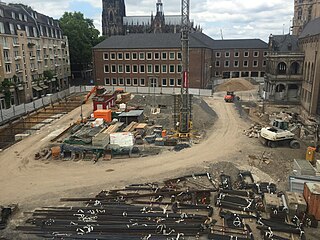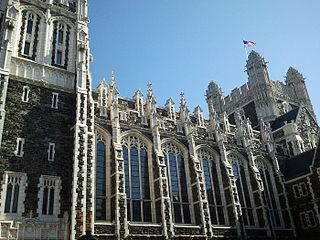
Construction is a general term meaning the art and science of forming objects, systems, or organizations. It comes from the Latin word constructio and Old French construction. To 'construct' is a verb: the act of building, and the noun is construction: how something is built or the nature of its structure.

Baruch College is a public college in New York City. It is a constituent college of the City University of New York system. Named for financier and statesman Bernard M. Baruch, the college operates undergraduate and postgraduate programs through the Zicklin School of Business, the Weissman School of Arts and Sciences, and the Marxe School of Public and International Affairs.

The Rhode Island School of Design is a private art and design school in Providence, Rhode Island. The school was founded as a coeducational institution in 1877 by Helen Adelia Rowe Metcalf, who sought to increase the accessibility of design education to women. Today, RISD offers bachelor's and master's degree programs across 19 majors and enrolls approximately 2,000 undergraduate and 500 graduate students. The Rhode Island School of Design Museum—which houses the school's art and design collections—is one of the largest college art museums in the United States.

Kohn Pedersen Fox Associates (KPF) is an American architectural firm based in New York City. that provides architecture, interior, programming and master planning services. They do different projects that includes civic and cultural spaces, commercial office buildings, transportation facilities, residential and hospitality developments, educational and institutional facilities, and mixed-use commercial developments. KPF has 600+ employees.

Green building refers to both a structure and the application of processes that are environmentally responsible and resource-efficient throughout a building's life-cycle: from planning to design, construction, operation, maintenance, renovation, and demolition. This requires close cooperation of the contractor, the architects, the engineers, and the client at all project stages. The Green Building practice expands and complements the classical building design concerns of economy, utility, durability, and comfort. Green building also refers to saving resources to the maximum extent, including energy saving, land saving, water saving, material saving, etc., during the whole life cycle of the building, protecting the environment and reducing pollution, providing people with healthy, comfortable and efficient use of space, and being in harmony with nature. Buildings that live in harmony; green building technology focuses on low consumption, high efficiency, economy, environmental protection, integration and optimization.’

The Bronx Community College of the City University of New York (BCC) is a public community college in the Bronx, New York City. It is part of the City University of New York system.
The Langston Hughes Medal has been awarded annually by the Langston Hughes Festival of the City College of New York since 1978. The medal "is awarded to highly distinguished writers from throughout the African American diaspora for their impressive works of poetry, fiction, drama, autobiography and critical essays that help to celebrate the memory and tradition of Langston Hughes. Each year, the LHF’s Advisory Committee reviews the work of major black writers from Africa to America whose work is accessed as likely having a lasting impact on world literature.".

The City College of the City University of New York is a public research university within the City University of New York (CUNY) system in New York City. Founded in 1847, City College was the first free public institution of higher education in the United States. It is the oldest of CUNY's 25 institutions of higher learning and is considered its flagship institution.

Maria C. Tamargo is a leading Cuban-American scientist in compound semiconductors and materials science. She is a professor of chemistry at The City College of New York.
Dolores Hayden is an American professor emerita of architecture, urbanism, and American studies at Yale University. She is an urban historian, architect, author, and poet. Hayden has made innovative contributions to the understanding of the social importance of urban space and to the history of the built environment in the United States.

New York City Department of Design and Construction is the department of the government of New York City that builds many of the civic facilities in New York City. As the city’s primary capital construction project manager, it provides new or renovated facilities such as firehouses, libraries, police precincts, courthouses and manage the city's sewer systems, bioswales and water mains. To manage this portfolio, valued at over $15 billion, the department works with other city agencies, as well as with architects and consultants.

Sustainable urbanism is both the study of cities and the practices to build them (urbanism), that focuses on promoting their long term viability by reducing consumption, waste and harmful impacts on people and place while enhancing the overall well-being of both people and place. Well-being includes the physical, ecological, economic, social, health and equity factors, among others, that comprise cities and their populations. In the context of contemporary urbanism, the term cities refers to several scales of human settlements from towns to cities, metropolises and mega-city regions that includes their peripheries / suburbs / exurbs. Sustainability is a key component to professional practice in urban planning and urban design along with its related disciplines landscape architecture, architecture, and civil and environmental engineering. Green urbanism and ecological urbanism are other common terms that are similar to sustainable urbanism, however they can be construed as focusing more on the natural environment and ecosystems and less on economic and social aspects. Also related to sustainable urbanism are the practices of land development called Sustainable development, which is the process of physically constructing sustainable buildings, as well as the practices of urban planning called smart growth or growth management, which denote the processes of planning, designing, and building urban settlements that are more sustainable than if they were not planned according to sustainability criteria and principles.

The Colin Powell School for Civic and Global Leadership at the City College of New York (CCNY) is a nonpartisan educational, training, and research center named for its founder, Colin Powell, a graduate of CCNY. The school is located at 160 Convent Avenue, in NAC building 6/141 on the CCNY campus, in West Harlem. The current dean is Andrew Rich.

Geeta Mehta is an Indian-American social entrepreneur, urban designer, architect and author. She is the co-founder of Asia Initiatives, and URBZ, and an adjunct professor at the Graduate School of Architecture Planning and Preservation at Columbia University.
Joseph F. Fuller, Jr. AIA, NCARB is a New York area architect specializing in Educational Architecture and Historic Preservation. He is best known for his firm's designs for the 2009 Academy of Information Technology & Engineering in Stamford, CT, the 2010 restoration and expansion of Old Town Hall, the expansion of Staples High School (Connecticut), and the restoration of the Gothic facades and campus of City College of New York.
Jerry Carlson has two intertwined careers, that of an academic and that of a maker of documentary films and television shows.

Active design is a set of building and planning principles that promote physical activity. Active design in a building, landscape or city design integrates physical activity into the occupants' everyday routines, such as walking to the store or making a photocopy. Active design involves urban planners, architects, transportation engineers, public health professionals, community leaders and other professionals in building places that encourage physical activity as an integral part of life. While not an inherent part of active design, most designers employing "active design" are also concerned with the productive life of their buildings and their building's ecological footprint.

Iris López is a contemporary professor, anthropologist, sociologist, and author, whose work focuses on feminist, Latino, and Latin American studies. She has one full-length book published, an ethnography about sterilization within female Puerto Rican populations, titled Matters of Choice. She received both her Masters and Doctoral degrees in Anthropology from Columbia University. Currently, López teaches sociology at the City College of New York, part of the City University of New York (CUNY), where she has been the Director of the Latin American and Latino Studies Program since 2016.
A sponge city is a new urban planning model in China that emphasizes flood management via strengthening green infrastructures instead of purely relying on drainage systems, proposed by Chinese researchers in early 2000 and accepted by the Chinese Communist Party (CCP) and the State Council as nationwide urban construction policy in 2014. The concept of sponge cities is that urban flooding, water shortage and heat island effect can be alleviated by having more urban parks, gardens, green spaces, wetlands, nature strips and permeable pavings, which will both improve ecological biodiversity for urban wildlife and reduce flash floods by serving as reservoirs for capturing, retaining and absorbing excess storm water. Harvested rainwater can be repurposed for irrigation and treated for home use if needed. It is a form of a sustainable drainage system on an urban scale and beyond.













